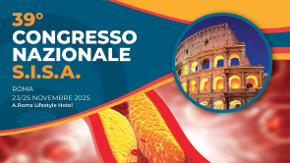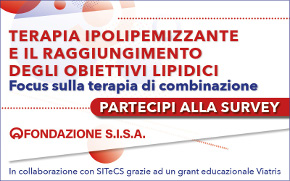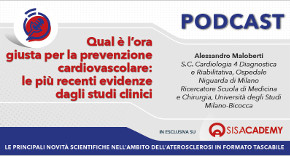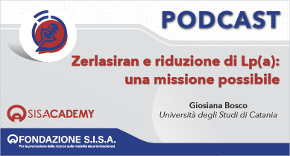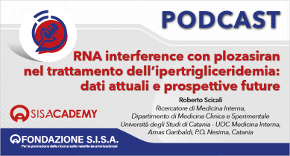 Rivista in lingua italiana
Rivista in lingua italiana
riservata ai Soci SISA
Ultimo numero:
Anno 16 • N.1/2025
SISANews
I depositi di calcio nelle coronarie confermano il loro valore predittivo nei confronti degli eventi cardiovascolari
I soggetti asintomatici con minimi depositi di calcio nelle coronarie hanno un rischio di eventi coronarici superiore di circa 3 volte a quello dei soggetti senza depositi di calcio. È quanto emerge da uno studio multietnico sull'aterosclerosi.
![]()
Cardiovascular events with absent or minimal coronary calcification: the Multi-Ethnic Study of Atherosclerosis (MESA)
Budoff MJ, McClelland RL, Nasir K, Greenland P, Kronmal RA, Kondos GT, Shea S, Lima JA, Blumenthal RS.
Am Heart J 2009;158:554-61
BACKGROUND: Elevated coronary artery calcium (CAC) is a marker for increase risk of coronary heart disease (CHD). Although most CHD events occur among individuals with advanced CAC, CHD can also occur in individuals with little or no calcified plaque. In this study, we sought to evaluate the characteristics associated with incident CHD events in the setting of minimal (score < or = 10) or absent CAC (score of zero). METHODS: Asymptomatic participants in the MESA (N = 6,809) were followed for occurrence of all CHD events (including myocardial infarction, angina, resuscitated cardiac arrest, or CHD death) and hard CHD events (myocardial infarction or CHD death). Time to incident CHD was modeled using age-and gender-adjusted Cox regression. RESULTS: The final study population consisted of 3,923 MESA asymptomatic participants (mean age 58 +/- 9 years, 39% males) who had CAC scores of 0 to 10. Overall, no detectable CAC was seen in 3415 individuals, whereas 508 had CAC scores of 1 to 10. During follow-up (median 4.1 years), there were 16 incident hard events and 28 all CHD events in individuals with absent or minimal CAC. In age-, gender-, race-, and CHD risk factor-adjusted analysis, minimal CAC (1-10) was associated with an estimated 3-fold greater risk of a hard CHD event (HR 3.23, 95% CI 1.17-8.95) or of all CHD event (HR 3.66, 95% CI 1.71-7.85) compared to those with CAC = 0. Former smoking (HR 3.57, 95% CI 1.08-11.77), current smoking (HR 4.93, 95% CI 1.20-20.30), and diabetes (HR 3.09, 95% CI 1.07-8.93) were significant risk factors for events in those with CAC = 0. CONCLUSION: Asymptomatic persons with absent or minimal CAC are at very low risk of future cardiovascular events. Individuals with minimal CAC (1-10) were significantly increased to 3-fold increased risk for incident CHD events relative to those with CAC scores of zero.

Area Soci
Eventi
39° Congresso Nazionale
 39° Congresso Nazionale
39° Congresso NazionaleRoma, 23-25 novembre 2025
Save the date




 Spring Meeting Gruppi Giovani SID, SIGG, SIIA, SIMI, SIPREC, SISA
Spring Meeting Gruppi Giovani SID, SIGG, SIIA, SIMI, SIPREC, SISARimini, 6-8 aprile 2025
[continua a leggere]
 SISA LIPID ACADEMY - Corso avanzato di lipidologia clinica
SISA LIPID ACADEMY - Corso avanzato di lipidologia clinicaModena, 4-5 Luglio 2024
[continua a leggere]Giornale Italiano Arteriosclerosi
HoFH today
 Rivista Italiana della
Rivista Italiana della
Ipercolesterolemia
Familiare Omozigote
Anno 6 • N.1/2024
Rivista NMCD
Diateca
[continua a leggere]
[continua a leggere]
Newsletter
il vostro indirizzo di posta elettronica
Progetto LIPIGEN

Nuovo sito dedicato al Progetto LIPIGEN
Progetto LIPIGEN - Vecchio portale
E' necessario essere loggati come utente
Lipigen per poter accedere alla pagina
PROject Statin Intolerance SISA
PROSISA – PROject Statin Intolerance SISA
E' necessario essere loggati come utente
PROSISA per poter accedere alla pagina
GILA - Lipoprotein Aferesi
Gruppo Interdisciplinare Lipoprotein Aferesi
(Accesso Gruppo GILA-Lipoprotein Aferesi)
E' necessario essere loggati come utente del Gruppo GILA per poter accedere
Gruppo Interdisciplinare Lipoprotein Aferesi
(Documentazione ad accesso libero)
Pagina informativa per medici e pazienti


